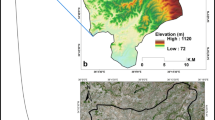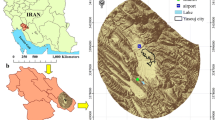Abstract
Rapid urbanization and physical development have produced a significant quantity of construction and demolition waste in Bonab, a city in northwest Iran. In order to achieve a high level of accuracy and minimize subjective bias, catastrophe theory (CT) principles were combined in the geographic information system (GIS) environment for identifying suitable locations for safe disposal of the waste. Site selection process for construction waste landfill (CWLF) in Bonab city involved preparation and integration of 12 maps representing elevation, slope, geology, soil type, land use, vegetation, distance to population centers, valuable ecosystems, river, groundwater, and access to the main roadways with the CT to reduce uncertainty associated with subjective evaluations. Evaluation of relative importance of the variables showed that elevation, slope, distance to the city, vegetation cover, and distance to communication networks have greater importance in site selection for construction waste landfill. On the contrary, distance to the river, groundwater level, distance to villages, and valuable ecosystems have the least impact. Suitable areas were identified in parts of the north and west of the city. The identified sites have a gentle slope, low agricultural potential, good access to the communication networks, suitable distance to the city, and no limitations regarding the groundwater level, geological formations, and vegetation cover.














Similar content being viewed by others
References
Ahmed, K., Shahid, S., Bin Harun, S., Ismail, T., Nawaz, N., & Shamsudin, S. (2015). Assessment of groundwater potential zones in an arid region based on catastrophe theory. Earth Science Informatics, 8(3), 539–549.
Al-Abadi, A., & Shahid, S. H. (2015). A comparison between index of entropy and catastrophe theory methods for mapping groundwater potential in an arid region. Environmental Monitoring and Assessment. https://doi.org/10.1007/s10661-015-4801-2
AlZaghrini, N., Srour, F. J., & Srour, I. (2019). Using GIS and optimization to manage construction and demolition waste: The case of abandoned quarries in Lebanon. Waste Management, 95, 139–149.
Banias, G., Achillas, C., Vlachokostas, C., Moussiopoulos, N., & Tarsenis, S. (2010). Assessing multiple criteria for the optimal location of a construction and demolition waste management facility. Building and Environment, 45(10), 2317–2326.
Bao, Z., & Lu, W. (2021). A decision-support framework for planning construction waste recycling: A case study of Shenzhen, China. Journal of Cleaner Production, 309, 127449.
Biluca, J., de Aguiar, C. R., & Trojan, F. (2020). Sorting of suitable areas for disposal of construction and demolition waste using GIS and ELECTRE TRI. Waste Management, 114, 307–320.
Din, M. A. M., Jaafar, W. Z. W., Obot, M. M., & Hussin, W. M. A. W. (2008, May). How GIS can be a useful tool to deal with landfill site selection. In International symposium on geoinformatics for spatial infrastructure development in earth and applied sciences (Vol. 57).
Ding, Z., Wen, X., Cao, X., & Yuan, H. (2022). A GIS and hybrid simulation aided environmental impact assessment of city-scale demolition waste management. Sustainable Cities and Society, 86, 104108.
Ding, Z., Zhu, M., Wu, Z., Fu, Y., & Liu, X. (2018). Combining AHP-entropy approach with GIS for construction waste landfill selection—A case study of Shenzhen. International Journal Of Environmental Research and Public Health, 15(10), 2254.
Kabirifar, K., Mojtahedi, M., Wang, C. C., & Tam, V. W. (2021). Effective construction and demolition waste management assessment through waste management hierarchy; A case of Australian large construction companies. Journal of Cleaner Production, 312, 127790.
Kheirizadeh Arouq, M., Esmaeilpour, M., & Sarvar, H. (2020). Vulnerability assessment of cities to earthquake based on the catastrophe theory: A case study of Tabriz city, Iran. Environmental Earth Sciences, 79(14), 1–21.
Kofoworola, O. F., & Gheewala, S. H. (2009). Estimation of construction waste generation and management in Thailand. Waste Management, 29(2), 731–738.
Li, H., Chen, Z., Yong, L., & Kong, S. C. (2005). Application of integrated GPS and GIS technology for reducing construction waste and improving construction efficiency. Automation in Construction, 14(3), 323–331.
Li, S. F. (2011, April). Assessment of flood hazard risk based on catastrophe theory in flood detention basins. In 2011 International Conference on Electric Technology and Civil Engineering (ICETCE) (pp. 139-142). IEEE.
Lu, W., Bao, Z., Lee, W. M., Chi, B., & Wang, J. (2021). An analytical framework of “zero waste construction site”: Two case studies of Shenzhen, China. Waste Management, 121, 343–353.
Nas, B., Cay, T., Iscan, F., & Berktay, A. (2010). Selection of MSW landfill site for Konya, Turkey using GIS and multi-criteria evaluation. Environmental Monitoring and Assessment, 160(1), 491–500.
Sadeghfam, S., Hassanzadeh, Y., Nadiri, A. A., & Khatibi, R. (2016). Mapping groundwater potential field using catastrophe fuzzy membership functions and Jenks optimization method: a case study of Maragheh-Bonab plain, Iran. Environmental Earth Sciences, 75, 545.
Su, S., Li, D., Yu, X., Zhang, Z., Zhang, Q., Xiao, R., Zhi, J., & Wu, J. (2011). Assessing land ecological security in Shanghai (China) based on catastrophe theory. Stochastic Environmental Research and Risk Assessment, 25(6), 737–746.
Tao, Y., Cao, J., Hu, J., & Dai, Z. (2013). A cusp catastrophe model of mid–long-term landslide evolution over low latitude highlands of China. Geomorphology, 187, 80–85.
USEPA (2022). Construction and demolition debris: Material-Specific Data. Construction and Demolition Debris: Material-Specific Data | US EPA. Accessed 18 June 2023.
Wang, W., Liu, S., Zhang, S., & Chen, J. (2011). Assessment of a model of pollution disaster in near-shore coastal waters based on catastrophe theory. Ecological Modelling, 222(2), 307–312.
Wu, H., Zuo, J., Yuan, H., Zillante, G., & Wang, J. (2019). A review of performance assessment methods for construction and demolition waste management. Resources, Conservation and Recycling, 150, 104407.
Xiao-jun, W., Jian-yun, Z., Shahid, S., Xing-hui, X., Rui-min, H., & Man-ting, S. (2014). Catastrophe theory to assess water security and adaptation strategy in the context of
Yao, P., Feng, Y., Xie, Q., Zhang, Y., & Zhang, P. (2022). Optimizing site selection for construction demolition waste treatment plants considering demand and supply uncertainty: A case study in Chongqing, China. Engineering Optimization, 1–20.
Zhang, L., Liu, X., Fu, Z., & Li, D. (2011). Evaluation of the rural informatization level in central China based on catastrophe progression method. In International conference on computer and computing technologies in agriculture (pp. 672–679). Springer.
Data availability
The datasets generated during and/or analyzed during the current study are available from the corresponding author on reasonable request.
Author information
Authors and Affiliations
Contributions
Marziyeh Esmaeilpour: Visualization, Writing- Original draft preparation, Software, Formal analysis, Methodology, Data curation, Investigation.
Corresponding author
Ethics declarations
Ethics approval
All authors have read, understood, and have complied as applicable with the statement on “Ethical responsibilities of Authors” as found in the Instructions for Authors.
Competing interests
The author declares no competing interests.
Additional information
Publisher’s Note
Springer Nature remains neutral with regard to jurisdictional claims in published maps and institutional affiliations.
Rights and permissions
Springer Nature or its licensor (e.g. a society or other partner) holds exclusive rights to this article under a publishing agreement with the author(s) or other rightsholder(s); author self-archiving of the accepted manuscript version of this article is solely governed by the terms of such publishing agreement and applicable law.
About this article
Cite this article
Esmaeilpour, M. Site selection for construction and demolition waste landfill using catastrophe theory: the case of Bonab city, Iran. Environ Monit Assess 195, 1409 (2023). https://doi.org/10.1007/s10661-023-12013-y
Received:
Accepted:
Published:
DOI: https://doi.org/10.1007/s10661-023-12013-y




